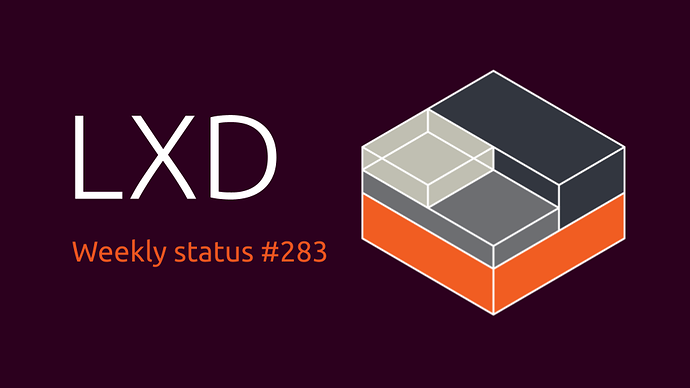Weekly status for the week of 23rd January to 29th January.
Introduction
This past week saw the addition of one of our LXD roadmap items, the Instance placement scriptlet feature, as well as the usual collection of improvements and bug fixes. See below for more information.
@stgraber has also added a video covering our the LXD LTS release process, as well as covering the items in our latest LXD 5.0.2 release:
Job openings
Canonical Ltd. strengthens its investment into LXD and is looking at building multiple squads under the technical leadership of @stgraber.
As such, we are looking for first line managers (highly technical) and individual contributors to grow the team and pursue our efforts around scalability and clustering.
All positions are 100% remote with some travel for internal events and conferences.
For more info please see LXD related openings at Canonical Ltd (2022-2023)
LXD
New features:
- Added Instance placement scriptlet support. This new feature allows for a custom script to control which cluster member is used to host a particular instance. The script is executed when LXD needs to know where to place an instance and its provided information about the cluster members which can then be used to implement custom domain logic to control how LXD places instances. See the Documentation and the Specification for more information.
Improvements:
- Added
locationfield toInstanceCreatedandStorageVolumeCreatedlifecycle events which indicates which cluster member the new entity will exist on. For remote storage volumes (such as ceph) thelocationfield will not be populated. - Documented the
lxc cluster infocommand.
Bug fixes:
- Fixed an issue with multicast and
macvlanNIC type when using VMs. This was causing IPv6 NDP to not work properly (because it relies on multicast). Although SLAAC IPv6 addresses were working, this turned out to be coincidental because the host-side macvlan interface had a SLAAC derived link-local address (which allowed multicast to work for that group). To fix the issue more generally theallmulticastflag is now enabled on the host-side interface. Additionally IPv6 is disabled entirely on the host-side interface to avoid it getting an unnecessary link-local address. - Fixed
diskdeviceraw.mount.optionssetting. Previously this was only supporting mount options (such asuidandgid) and not mount flags (such asroandnosuid).
LXD Charm
Improvements:
- Added Auto-update Charm Libraries workflow.
YouTube videos
The LXD team is running a YouTube channel with live streams covering LXD releases and weekly videos on different aspects of LXD. You may want to give it a watch and/or subscribe for more content in the coming weeks.
Contribute to LXD
Ever wanted to contribute to LXD but not sure where to start?
We’ve recently gone through some effort to properly tag issues suitable for new contributors on Github: Easy issues for new contributors
Upcoming events
- FOSDEM 2023 4th-5th February 2023. See FOSDEM 2023 containers devroom: Call for papers
Ongoing projects
The list below is feature or refactoring work which will span several weeks/months and can’t be tied directly to a single Github issue or pull request.
- Stable release work for LXC, LXCFS and LXD
Upstream changes
The items listed below are highlights of the work which happened upstream over the past week and which will be included in the next release.
LXD
- Instance: Add support for placement Starlark scriptlet
- drivers: Unify allowed filesystems variable
- lxd/migration: Remove leftover stats definitions
- doc/clustering: document
lxc cluster info - Device: Allow all multicast to fix IPv6 NDP for
macvlanNICs in VMs - Adds location to event context on instance and local storage volume creation
- Device: Fix
diskdeviceraw.mount.optionssetting
LXC
LXCFS
- Nothing to report this week
Distrobuilder
- Nothing to report this week
Dqlite (RAFT library)
- Nothing to report this week
LXD Charm
Distribution work
This section is used to track the work done in downstream Linux distributions to ship the latest LXC, LXD and LXCFS as well as work to get various software to work properly inside containers.
Ubuntu
- Nothing to report this week
Snap
- Nothing to report this week


